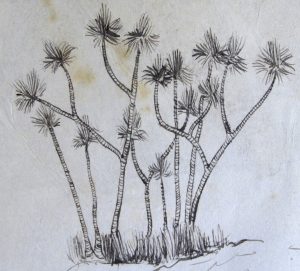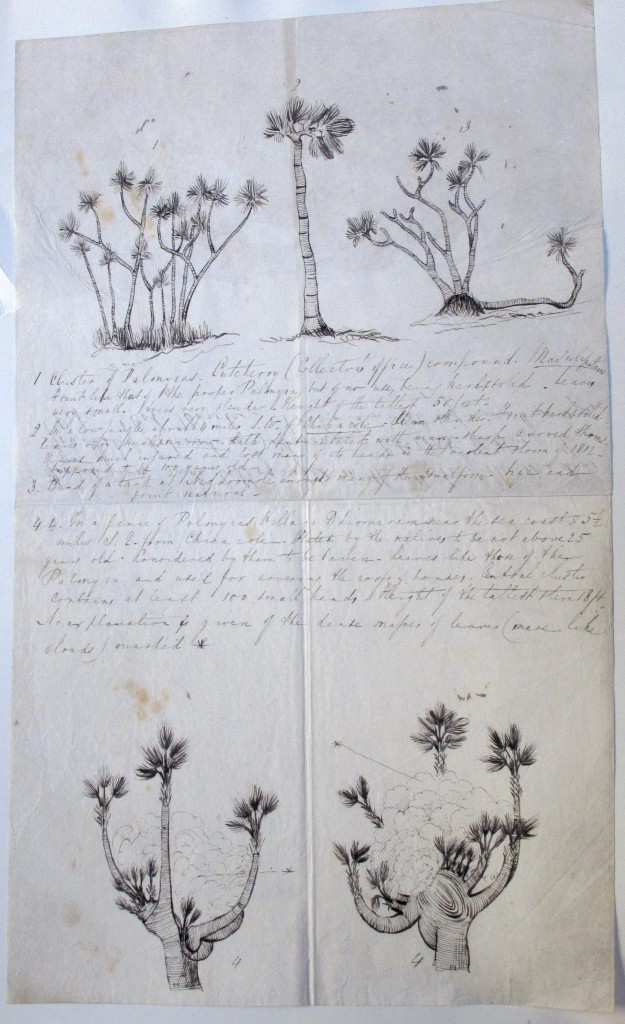 The historical RBGE Illustrations Collection contains a wealth of images from a wide variety of sources – from original drawings to newspaper cuttings. Information on the source was nearly always discarded when the images were filed solely according to the name of the species depicted. For 13 years I have (on and off) been working on this collection, trying to identify the lost sources of the more interesting drawings. The attached image has always puzzled me though, with references to places on the Andhra Pradesh coast, clearly Indian in origin; the sheet shows some decidedly odd palms all described as ‘palmyras’. But the true palmyra palm, Borassus flabellifer, normally has an unbranched trunk.
The historical RBGE Illustrations Collection contains a wealth of images from a wide variety of sources – from original drawings to newspaper cuttings. Information on the source was nearly always discarded when the images were filed solely according to the name of the species depicted. For 13 years I have (on and off) been working on this collection, trying to identify the lost sources of the more interesting drawings. The attached image has always puzzled me though, with references to places on the Andhra Pradesh coast, clearly Indian in origin; the sheet shows some decidedly odd palms all described as ‘palmyras’. But the true palmyra palm, Borassus flabellifer, normally has an unbranched trunk.
 One of my regular correspondents on the history of Indian natural history is a Madras-born entomologist and agro-ecologist Dr A. Raman based in Australia. We have been discussing a pupil of the Madras Medical College called Senji Pulney Andey, who in 1860 was the first Indian to gain an MD from the University of St Andrews. One of Andey’s teachers was Hugh Cleghorn, whose collection of drawings is a major part of the Illustrations Collection, but the recent communications were about a paper by Pulney Andey on abnormal forms of Indian palms – the palmyra and coconut. Raman told me of an earlier report of weird palms published in 1833 in the Madras Journal of Literature and Science. And this turns out to be the source for the mysterious Edinburgh sheet. The drawings are copied, and the text summarised, from this paper written by Lt. Col. W.S. Bowler Superintendent of Roads for the Northern Division of the Madras Presidency, one of many military men who contributed to knowledge of Indian natural history in the Colonial period. The sheet is also a fascinating reminder of how information was copied and transmitted in days before photocopiers, let alone the Internet.
One of my regular correspondents on the history of Indian natural history is a Madras-born entomologist and agro-ecologist Dr A. Raman based in Australia. We have been discussing a pupil of the Madras Medical College called Senji Pulney Andey, who in 1860 was the first Indian to gain an MD from the University of St Andrews. One of Andey’s teachers was Hugh Cleghorn, whose collection of drawings is a major part of the Illustrations Collection, but the recent communications were about a paper by Pulney Andey on abnormal forms of Indian palms – the palmyra and coconut. Raman told me of an earlier report of weird palms published in 1833 in the Madras Journal of Literature and Science. And this turns out to be the source for the mysterious Edinburgh sheet. The drawings are copied, and the text summarised, from this paper written by Lt. Col. W.S. Bowler Superintendent of Roads for the Northern Division of the Madras Presidency, one of many military men who contributed to knowledge of Indian natural history in the Colonial period. The sheet is also a fascinating reminder of how information was copied and transmitted in days before photocopiers, let alone the Internet.
Three of the images on the sheet appear to show abnormal Borassus, in which the shoot apex has been caused to branch, probably in response to insect damage. Two of the other thumbnails show one of the very few palms that in normal growth have dichotomously branched stems. These belong to the genus Hyphaene, the best-known of which is the doum palm of Egypt (H. thebaica). There is also a species native to the west coast of India (Gujarat) called H. indica, but these east-coast ones require re-examination (if they still occur); they may have been introduced in historical times by sea-borne traders and as easily come from Arabia as from Gujarat. Can anyone in Andhra Pradesh tell me if Hyphaene still occurs there?


1 Comment
1 Pingback